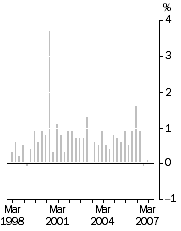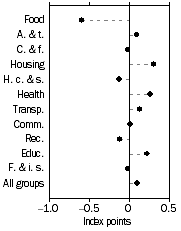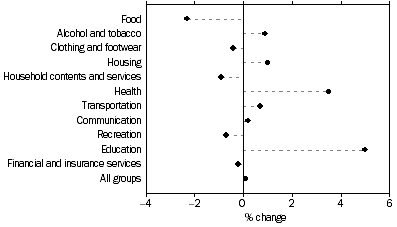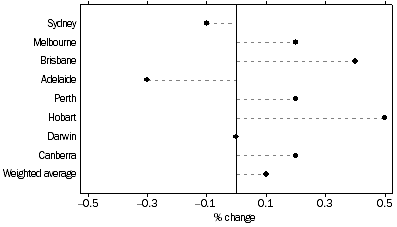PRICE INDEXES AND CONTRACT PRICE INDEXATION
MARCH QTR KEY FIGURES
 | Dec Qtr 2006
to Mar Qtr 2007 | Mar Qtr 2006
to Mar Qtr 2007 |
| Weighted average of eight capital cities | % change | % change |
|
| Food | -2.3 | 4.6 |
| Alcohol and tobacco | 0.9 | 3.1 |
| Clothing and footwear | -0.4 | 0.2 |
| Housing | 1.0 | 3.5 |
| Household contents and services | -0.9 | 1.4 |
| Health | 3.5 | 4.4 |
| Transportation | 0.7 | 0.5 |
| Communication | 0.2 | 1.4 |
| Recreation | -0.7 | 1.1 |
| Education | 5.0 | 4.2 |
| Financial and insurance services | -0.2 | 1.8 |
| All groups | 0.1 | 2.4 |
| All groups excluding Housing and Financial and insurance services | -0.1 | 2.3 |
|
All Groups,
Quarterly change

| Contribution to quarterly change,
March quarter 2007

|
MARCH QTR KEY POINTS
THE ALL GROUPS CPI
- rose 0.1% in the March quarter 2007, a slight increase from the fall of 0.1% in the December quarter.
- rose 2.4% through the year to March quarter 2007.
OVERVIEW OF CPI MOVEMENTS
- The most significant price rises this quarter were for pharmaceuticals (+12.8%), house purchase (+1.0%), secondary education fees (+7.1%) and rents (+1.4%).
- The most significant offsetting price decreases were fruit (-33.8%), with banana prices returning to the levels of March quarter 2006, furniture (-3.3%), overseas holiday travel and accommodation (-2.2%) and audio, visual and computing equipment (-2.4%).
NOTES
FORTHCOMING ISSUES
| ISSUE (QUARTER) | Release Date |
| June 2007 | 25 July 2007 |
| September 2007 | 24 October 2007 |
ROUNDING
Any discrepancies between totals and sums of components in this publication are due to rounding.
CHANGES IN THIS ISSUE
Change to New Zealand CPI series in the International Comparisons in tables 11 and 12.
In September quarter 2006, Statistics New Zealand released a revised CPI series with reference base of June quarter 2006. This followed a major review involving changes to their representative basket of goods and services as well as changes to expenditure weights. The revised series is presented in tables 11 and 12. For details on these changes, please contact Statistics New Zealand through their website <http://www.stats.govt.nz>.
FORTHCOMING CHANGES
ABS to publish the RBA's consumer price measures.
The Australian Bureau of Statistics and the Reserve Bank of Australia have agreed that the ABS will publish on behalf of the RBA its trimmed mean and weighted median consumer price measures.
Publication of the measures by the ABS will commence in the June Quarter 2007 issue of Consumer Price Index, Australia (cat. no. 6401.0) which will be released on 25 July 2007.
The measures will appear in tables 9 and 10, along with other analytical price series. The ABS will publish an information paper on 11 July 2007 that will show how the series will appear in the publication.
For more information see the media release on the ABS website <https://www.abs.gov.au> under News and Media Releases, All Media Releases, April 2007.
ABBREVIATIONS
ABS Australian Bureau of Statistics
CPI Consumer Price Index
INQUIRIES
For further information about these and related statistics, contact Lee Taylor on Canberra (02) 6252 6251 or the National Information and Referral Service on 1300 135 070.
SUMMARY COMMENTARY
MAIN CONTRIBUTORS TO CHANGE
CPI GROUPS
Weighted average of eight capital cities, Percentage change from previous quarter

The discussion of the CPI groups below is ordered in terms of their absolute significance to the change in All groups index points (see tables 6 and 7).
FOOD (-2.3%)
The fall in food prices was mainly due to fruit (-33.8%), with minor contributions from breakfast cereals (-5.0%), lamb and mutton (-3.1%) and beef and veal (-1.0%). These falls were partially offset by rises in all other food items, ranging from tea, coffee and food drinks (+0.1%) to take away and fast foods (+1.6%).
The fall in fruit prices was again largely due to the lower quarterly average price of bananas. Banana prices rose 406% over the June and September quarters 2006, fell 19% in December quarter 2006 and a further 73% in March quarter 2007. Banana prices are now at levels similar to those of March quarter 2006. Prices of most other fruit also fell throughout the quarter, with a small number of offsetting price rises, notably in apples (+4.8%) and citrus fruit (+3.6%).
Over the twelve months to March quarter 2007, food prices rose 4.6%, mainly due to increases in fruit (+14.9%) and take away and fast foods (+4.0%). The only significant offsetting annual fall was in beef and veal (-2.3%).
HOUSING (+1.0%)
The rise in housing this quarter was mainly due to house purchase (+1.0%) and rents (+1.4%).
Increases in house purchase prices were recorded in all capital cities except Adelaide, which was unchanged. Rises in other cities ranged from 0.4% in Sydney to 3.3% in Brisbane. Average rents rose in all capital cities, ranging from 0.9% in Adelaide to 2.6% in Perth.
Through the year to March quarter 2007, the housing group rose 3.5%. This rise was mainly attributable to rents (+4.4%), house purchase (+2.9%), and property rates and charges (+5.6%). Annually, housing increases were led by rises in Darwin (+8.5%) and Perth (+6.9%).
HEALTH (+3.5%)
The rise in health costs was due to pharmaceuticals (+12.8%), hospital and medical services (+1.0%) and dental services (+1.1%).
Pharmaceuticals prices rose as a result of the cyclical reduction in the proportion of consumers who qualify for subsidised medications under the Pharmaceuticals Benefit Scheme at the start of each calendar year. The rise in hospital and medical services reflects increases in gross fees for most medical practitioners' services, combined with a cyclical reduction in the proportion of consumers who qualify for subsidies for out-of-hospital medical expenses under the Medicare Plus safety net at the start of each calendar year. This was partly offset by a small increase in the overall bulk billing ratio for medical services.
Through the year to March quarter 2007, the health group rose 4.4%, mainly due to an increase in net hospital and medical services (+5.9%).
EDUCATION (+5.0%)
Fees for all levels of education rose in the March quarter, with the commencement of the new school year. Secondary education rose 7.1%, preschool and primary education rose 6.6% and tertiary education rose 2.6%.
Secondary education was the major contributor, with wide-spread fee increases at private and most government schools. Preschool and primary education fees rose to cover increases in wages and other operating costs.
The rise in tertiary education was due to rises in all tertiary education fees. Increases in TAFE and HECS fees were the main contributors to this movement.
Through the year to March quarter 2007, the education group rose 4.2%.
TRANSPORTATION (+0.7%)
The main contributor to the 0.7% increase in transportation costs this quarter was a small rise in the price of automotive fuel (+1.4%). All other categories in transportation also rose, with motor vehicle parts and accessories (+1.2%) and other motoring charges (+1.2%) being the most significant.
Automotive fuel prices fell in October (-6.3%) and November (-1.9%), rose in December (+2.8%), fell in January (-3.0%) then rose in February (+1.1%) and March (+7.6%). The automotive fuel expenditure class contributed 0.09 index points to the increase in the All Groups CPI in March quarter 2007 and -0.14 index points to the through the year change.
The following graph shows the pattern of the average daily prices for unleaded petrol for the eight capital cities over the last fifteen months.
Through the year to March quarter 2007, the transportation group rose 0.5%, with the main contributors being other motoring charges (+4.9%), motor vehicle repair and servicing (+2.6%), motor vehicle parts and accessories (+3.8%) and urban transport fares (+3.0%). A fall in automotive fuel (-2.3%) provided the only offset.
HOUSEHOLD CONTENTS AND SERVICES (-0.9%)
The fall in household contents and services prices was mainly due to furniture (-3.3%), towels and linen (-4.9%) and glassware, tableware and household utensils (-2.2%). The strongest offsetting movement was a rise in child care (+5.4%).
The rise in the net price of child care was mainly due to increases in gross fees, with many providers reviewing fees at the start of a new year to cover increases in wages and other running costs. Increases in the number of families exceeding thresholds for the Child Care Benefit, as family income levels rose, meant that the net benefit of subsidies was reduced. This had the effect of a small increase in out-of-pocket expenses.
Through the year to March quarter 2007, the household contents and services group rose 1.4%.
RECREATION (-0.7%)
The fall in recreation was due mainly to overseas holiday travel and accommodation (-2.2%), audio, visual and computing equipment (-2.4%) and domestic holiday travel and accommodation (-1.3%). The major offsetting price rise was in other recreational activities (+1.1%).
Annually, Recreation rose 1.1% with the strongest rises in domestic holiday travel and accommodation (+5.2%) and other recreational activities (4.9%).
ALCOHOL AND TOBACCO (+0.9%)
All four components in the alcohol and tobacco group rose this quarter with the most significant being contributions from tobacco (+1.4%), beer (+0.7%), and spirits (+1.1%).
The rises in tobacco, beer, and spirit prices are attributed to the effects of the increase in Federal excise and customs duty from 1 February and to some discontinuation of specials. There was a small increase in wine prices (+0.1%).
Through the year to March quarter 2007, the alcohol and tobacco group rose 3.1%, with rises in all categories except wine, which fell 0.6% over the year.
TRADABLES AND NON-TRADABLES
The non-tradables component (see table 8) of the CPI rose 0.9% in the March quarter. This component includes goods and services whose prices are largely determined by domestic price pressures and represents approximately 58% of the CPI. Within non-tradables, the services component rose 0.7%, mainly due to secondary education fees and rents. The major offset was provided by deposit and loan facilities. The non-tradable goods component rose 1.3% mainly due to house purchase.
The tradables component of the All groups CPI fell 1.0%. This component includes goods and services whose prices are largely determined on the world market and represents approximately 42% of the weight of the CPI. The main contributor to the decrease was fruit. The most significant offsets were rises in pharmaceuticals and automotive fuel.
Through the year to March quarter 2007, non-tradables rose 3.5% and tradables rose 1.0%. This compares with rises of 3.5% and 2.9%, respectively, for these components through the year to December quarter 2006.
CAPITAL CITIES COMPARISON
ALL GROUPS
All Groups: Percentage change from previous quarter

At the All groups level, the CPI rose in Hobart (+0.5%), Brisbane (+0.4%), Melbourne (+0.2%), Canberra (+0.2%), and Perth (+0.2%), showed no overall movement in Darwin (0.0%) and fell in Adelaide (-0.3%), Sydney (-0.1%).
Significant falls in fruit prices were recorded in all cities, due mainly to the fall in banana prices. In Hobart the impact of price rises in automotive fuel, pharmaceuticals and electricity more than offset this impact. In Adelaide, rises in electricity, pharmaceuticals and automotive fuel were not sufficient to offset the falls in fruit and overseas holiday travel and accommodation.
Through the year to March quarter 2007, the All groups CPI rose in all capital cities with the increases ranging from 1.8% in Adelaide to 4.0% in Darwin. The higher result for Darwin was largely due to an 8.5% rise in Housing, more than double the 3.5% increase for the weighted average of eight capital cities. Perth also recorded a strong rise for Housing (+6.9%) that was almost double the national average.
CPI, All groups index numbers and percentage changes |
|  |
 | Index number(a) | Percentage change |  |
 | Mar Qtr 2007 | Dec Qtr 2006
to Mar Qtr 2007 | Mar Qtr 2006
to Mar Qtr 2007 |  |
|  |
| Sydney | 155.6 | -0.1 | 2.2 |  |
| Melbourne | 153.8 | 0.2 | 2.2 |  |
| Brisbane | 158.0 | 0.4 | 2.9 |  |
| Adelaide | 158.4 | -0.3 | 1.8 |  |
| Perth | 155.8 | 0.2 | 3.5 |  |
| Hobart | 155.4 | 0.5 | 2.1 |  |
| Darwin | 152.6 | 0.0 | 4.0 |  |
| Canberra | 155.9 | 0.2 | 2.4 |  |
| Weighted average of eight capital cities | 155.6 | 0.1 | 2.4 |  |
|  |
| (a) Base of each index: 1989-90 = 100.0. |
 |
SELECTED TABLES FROM CONSUMER PRICE INDEX, AUSTRALIA (CAT. NO. 6401.0)
1 ALL GROUPS, INDEX NUMBERS(a)
ALL GROUPS, Index numbers(a) |
|
| Period | Sydney | Melbourne | Brisbane | Adelaide | Perth | Hobart | Darwin | Canberra | Weighted
average
of eight
capital
cities |
|
| 2002-03 | 141.1 | 139.7 | 140.7 | 142.7 | 136.8 | 139.1 | 136.8 | 139.7 | 140.2 |
| 2003-04 | 144.1 | 142.8 | 144.8 | 147.0 | 139.6 | 142.6 | 138.7 | 143.4 | 143.5 |
| 2004-05 | 147.7 | 145.7 | 148.5 | 150.4 | 144.0 | 147.1 | 141.8 | 146.7 | 147.0 |
| 2005-06 | 152.1 | 150.2 | 153.2 | 155.2 | 150.1 | 151.8 | 146.5 | 151.9 | 151.7 |
| 2003 |  |  |  |  |  |  |  |  |  |
| March | 142.1 | 140.9 | 141.8 | 144.6 | 137.4 | 140.0 | 137.5 | 140.7 | 141.3 |
| June | 142.2 | 140.9 | 141.8 | 144.3 | 137.4 | 140.8 | 137.9 | 140.7 | 141.3 |
| September | 142.4 | 141.8 | 143.3 | 145.4 | 138.6 | 141.1 | 137.8 | 141.9 | 142.1 |
| December | 143.6 | 142.1 | 144.2 | 146.2 | 139.2 | 142.0 | 138.5 | 142.9 | 142.8 |
| 2004 |  |  |  |  |  |  |  |  |  |
| March | 145.0 | 143.5 | 145.4 | 147.7 | 139.6 | 143.0 | 139.0 | 143.9 | 144.1 |
| June | 145.5 | 143.9 | 146.3 | 148.6 | 141.0 | 144.3 | 139.6 | 144.8 | 144.8 |
| September | 146.2 | 144.2 | 146.8 | 149.0 | 142.0 | 145.0 | 140.8 | 145.5 | 145.4 |
| December | 147.3 | 145.3 | 148.0 | 150.0 | 143.3 | 146.7 | 141.1 | 146.3 | 146.5 |
| 2005 |  |  |  |  |  |  |  |  |  |
| March | 148.2 | 146.4 | 149.2 | 150.9 | 144.4 | 148.0 | 141.9 | 147.0 | 147.5 |
| June | 149.0 | 146.9 | 150.0 | 151.8 | 146.3 | 148.8 | 143.2 | 147.8 | 148.4 |
| September | 150.5 | 148.6 | 150.9 | 153.4 | 147.8 | 150.1 | 144.7 | 149.7 | 149.8 |
| December | 151.0 | 149.2 | 152.1 | 154.1 | 149.0 | 151.0 | 145.4 | 150.9 | 150.6 |
| 2006 |  |  |  |  |  |  |  |  |  |
| March | 152.2 | 150.5 | 153.5 | 155.6 | 150.5 | 152.2 | 146.7 | 152.2 | 151.9 |
| June | 154.7 | 152.6 | 156.2 | 157.6 | 153.2 | 154.0 | 149.2 | 154.9 | 154.3 |
| September | 156.1 | 153.7 | 157.5 | 159.3 | 154.9 | 155.1 | 151.8 | 156.0 | 155.7 |
December
2007
March | 155.8
155.6 | 153.5
153.8 | 157.3
158.0 | 158.8
158.4 | 155.5
155.8 | 154.7
155.4 | 152.6
152.6 | 155.6
155.9 | 155.5
155.6 |
|
| (a) Base of each index: 1989-90 = 100.0. |
|
2 ALL GROUPS, PERCENTAGE CHANGES
ALL GROUPS, Percentage changes |
|
| Period | Sydney | Melbourne | Brisbane | Adelaide | Perth | Hobart | Darwin | Canberra | Weighted
average
of eight
capital
cities |
Percentage Change (from previous financial year) |
|
| 2002-03 | 2.8 | 3.3 | 3.2 | 4.0 | 2.8 | 3.3 | 2.3 | 3.3 | 3.1 |
| 2003-04 | 2.1 | 2.2 | 2.9 | 3.0 | 2.0 | 2.5 | 1.4 | 2.6 | 2.4 |
| 2004-05 | 2.5 | 2.0 | 2.6 | 2.3 | 3.2 | 3.2 | 2.2 | 2.3 | 2.4 |
| 2005-06 | 3.0 | 3.1 | 3.2 | 3.2 | 4.2 | 3.2 | 3.3 | 3.5 | 3.2 |
Percentage Change (from corresponding quarter of previous year) |
|
 |  |  |  |  |  |  |  |  |  |
| 2003 |  |  |  |  |  |  |  |  |  |
| March | 3.0 | 3.6 | 3.4 | 5.0 | 2.8 | 3.6 | 2.8 | 3.8 | 3.4 |
| June | 2.4 | 2.9 | 2.7 | 3.7 | 2.1 | 2.8 | 2.1 | 2.6 | 2.7 |
| September | 2.0 | 2.9 | 2.9 | 3.6 | 2.1 | 2.6 | 1.8 | 2.8 | 2.6 |
| December | 2.3 | 2.2 | 3.1 | 3.3 | 2.1 | 2.9 | 1.7 | 2.7 | 2.4 |
| 2004 |  |  |  |  |  |  |  |  |  |
| March | 2.0 | 1.8 | 2.5 | 2.1 | 1.6 | 2.1 | 1.1 | 2.3 | 2.0 |
| June | 2.3 | 2.1 | 3.2 | 3.0 | 2.6 | 2.5 | 1.2 | 2.9 | 2.5 |
| September | 2.7 | 1.7 | 2.4 | 2.5 | 2.5 | 2.8 | 2.2 | 2.5 | 2.3 |
| December | 2.6 | 2.3 | 2.6 | 2.6 | 2.9 | 3.3 | 1.9 | 2.4 | 2.6 |
| 2005 |  |  |  |  |  |  |  |  |  |
| March | 2.2 | 2.0 | 2.6 | 2.2 | 3.4 | 3.5 | 2.1 | 2.2 | 2.4 |
| June | 2.4 | 2.1 | 2.5 | 2.2 | 3.8 | 3.1 | 2.6 | 2.1 | 2.5 |
| September | 2.9 | 3.1 | 2.8 | 3.0 | 4.1 | 3.5 | 2.8 | 2.9 | 3.0 |
| December | 2.5 | 2.7 | 2.8 | 2.7 | 4.0 | 2.9 | 3.0 | 3.1 | 2.8 |
| 2006 |  |  |  |  |  |  |  |  |  |
| March | 2.7 | 2.8 | 2.9 | 3.1 | 4.2 | 2.8 | 3.4 | 3.5 | 3.0 |
| June | 3.8 | 3.9 | 4.1 | 3.8 | 4.7 | 3.5 | 4.2 | 4.8 | 4.0 |
| September | 3.7 | 3.4 | 4.4 | 3.8 | 4.8 | 3.3 | 4.9 | 4.2 | 3.9 |
December
2007
March | 3.2
2.2 | 2.9
2.2 | 3.4
2.9 | 3.0
1.8 | 4.4
3.5 | 2.5
2.1 | 5.0
4.0 | 3.1
2.4 | 3.3
2.4 |
Percentage Change (from previous quarter) |
|
 |  |  |  |  |  |  |  |  |  |
| 2003 |  |  |  |  |  |  |  |  |  |
| March | 1.2 | 1.4 | 1.4 | 2.2 | 0.7 | 1.4 | 1.0 | 1.1 | 1.3 |
| June | 0.1 | 0.0 | 0.0 | -0.2 | 0.0 | 0.6 | 0.3 | 0.0 | 0.0 |
| September | 0.1 | 0.6 | 1.1 | 0.8 | 0.9 | 0.2 | -0.1 | 0.9 | 0.6 |
| December | 0.8 | 0.2 | 0.6 | 0.6 | 0.4 | 0.6 | 0.5 | 0.7 | 0.5 |
| 2004 |  |  |  |  |  |  |  |  |  |
| March | 1.0 | 1.0 | 0.8 | 1.0 | 0.3 | 0.7 | 0.4 | 0.7 | 0.9 |
| June | 0.3 | 0.3 | 0.6 | 0.6 | 1.0 | 0.9 | 0.4 | 0.6 | 0.5 |
| September | 0.5 | 0.2 | 0.3 | 0.3 | 0.7 | 0.5 | 0.9 | 0.5 | 0.4 |
| December | 0.8 | 0.8 | 0.8 | 0.7 | 0.9 | 1.2 | 0.2 | 0.5 | 0.8 |
| 2005 |  |  |  |  |  |  |  |  |  |
| March | 0.6 | 0.8 | 0.8 | 0.6 | 0.8 | 0.9 | 0.6 | 0.5 | 0.7 |
| June | 0.5 | 0.3 | 0.5 | 0.6 | 1.3 | 0.5 | 0.9 | 0.5 | 0.6 |
| September | 1.0 | 1.2 | 0.6 | 1.1 | 1.0 | 0.9 | 1.0 | 1.3 | 0.9 |
| December | 0.3 | 0.4 | 0.8 | 0.5 | 0.8 | 0.6 | 0.5 | 0.8 | 0.5 |
| 2006 |  |  |  |  |  |  |  |  |  |
| March | 0.8 | 0.9 | 0.9 | 1.0 | 1.0 | 0.8 | 0.9 | 0.9 | 0.9 |
| June | 1.6 | 1.4 | 1.8 | 1.3 | 1.8 | 1.2 | 1.7 | 1.8 | 1.6 |
| September | 0.9 | 0.7 | 0.8 | 1.1 | 1.1 | 0.7 | 1.7 | 0.7 | 0.9 |
December
2007
March | -0.2
-0.1 | -0.1
0.2 | -0.1
0.4 | -0.3
-0.3 | 0.4
0.2 | -0.3
0.5 | 0.5
0.0 | -0.3
0.2 | -0.1
0.1 |
|
LONGER TERM SERIES:
CPI All Groups, Weighted Average of Eight Capital Cities, Index Numbers(a)
|
 |  |  |  | Quarter ending |
|
| Year | 31 March | 30 June | 30 September | 31 December |
|
| 1985 | 68.1 | 69.7 | 71.3 | 72.7 |
| 1986 | 74.4 | 75.6 | 77.6 | 79.8 |
| 1987 | 81.4 | 82.6 | 84.0 | 85.5 |
| 1988 | 87.0 | 88.5 | 90.2 | 92.0 |
| 1989 | 92.9 | 95.2 | 97.4 | 99.2 |
| 1990 | 100.9 | 102.5 | 103.3 | 106.0 |
| 1991 | 105.8 | 106.0 | 106.6 | 107.6 |
| 1992 | 107.6 | 107.3 | 107.4 | 107.9 |
| 1993 | 108.9 | 109.3 | 109.8 | 110.0 |
| 1994 | 110.4 | 111.2 | 111.9 | 112.8 |
| 1995 | 114.7 | 116.2 | 117.6 | 118.5 |
| 1996 | 119.0 | 119.8 | 120.1 | 120.3 |
| 1997 | 120.5 | 120.2 | 119.7 | 120.0 |
| 1998 | 120.3 | 121.0 | 121.3 | 121.9 |
| 1999 | 121.8 | 122.3 | 123.4 | 124.1 |
| 2000 | 125.2 | 126.2 | 130.9 | 131.3 |
| 2001 | 132.7 | 133.8 | 134.2 | 135.4 |
| 2002 | 136.6 | 137.6 | 138.5 | 139.5 |
| 2003 | 141.3 | 141.3 | 142.1 | 142.8 |
| 2004 | 144.1 | 144.8 | 145.4 | 146.5 |
| 2005 | 147.5 | 148.4 | 149.8 | 150.6 |
2006
2007 | 151.9
155.6 | 154.3 | 155.7 | 155.5 |
|
| (a) Base of each index:1989-90 = 100.0 |
 Print Page
Print Page
 Print All
Print All